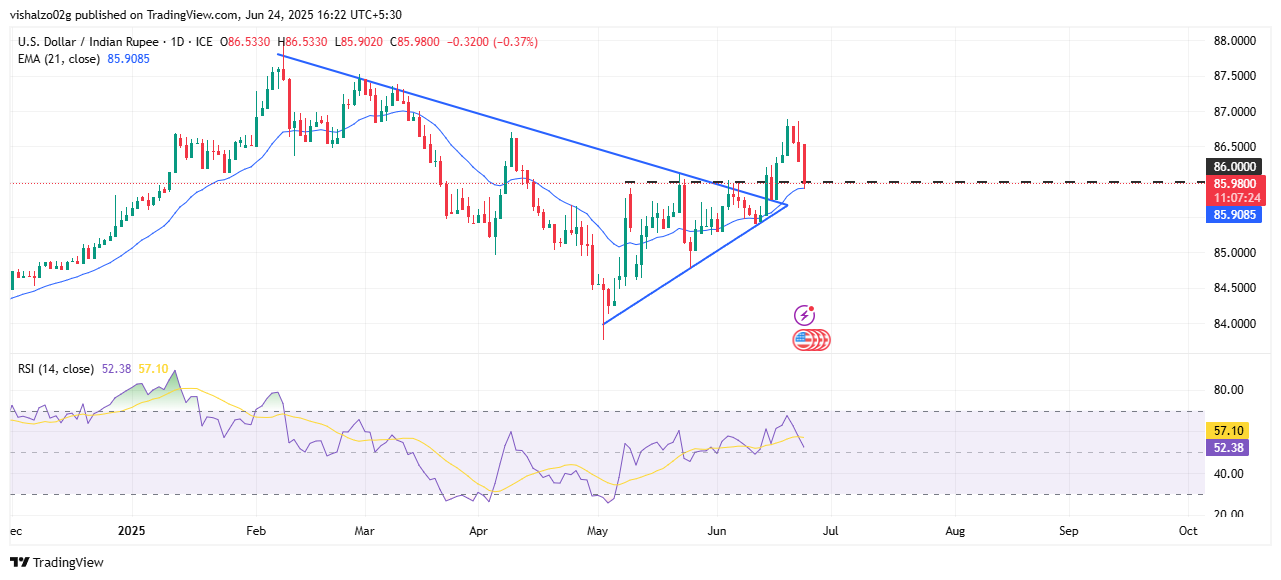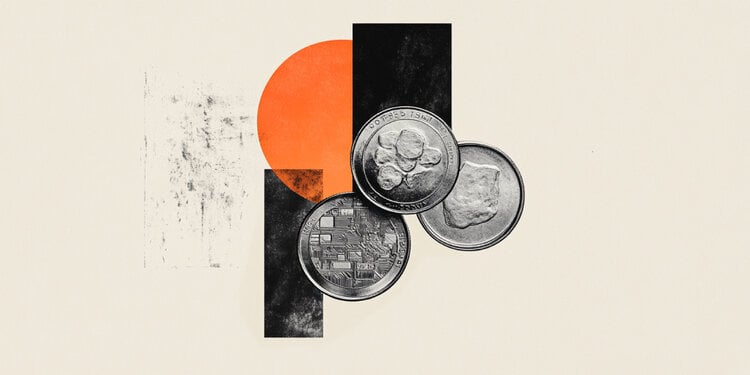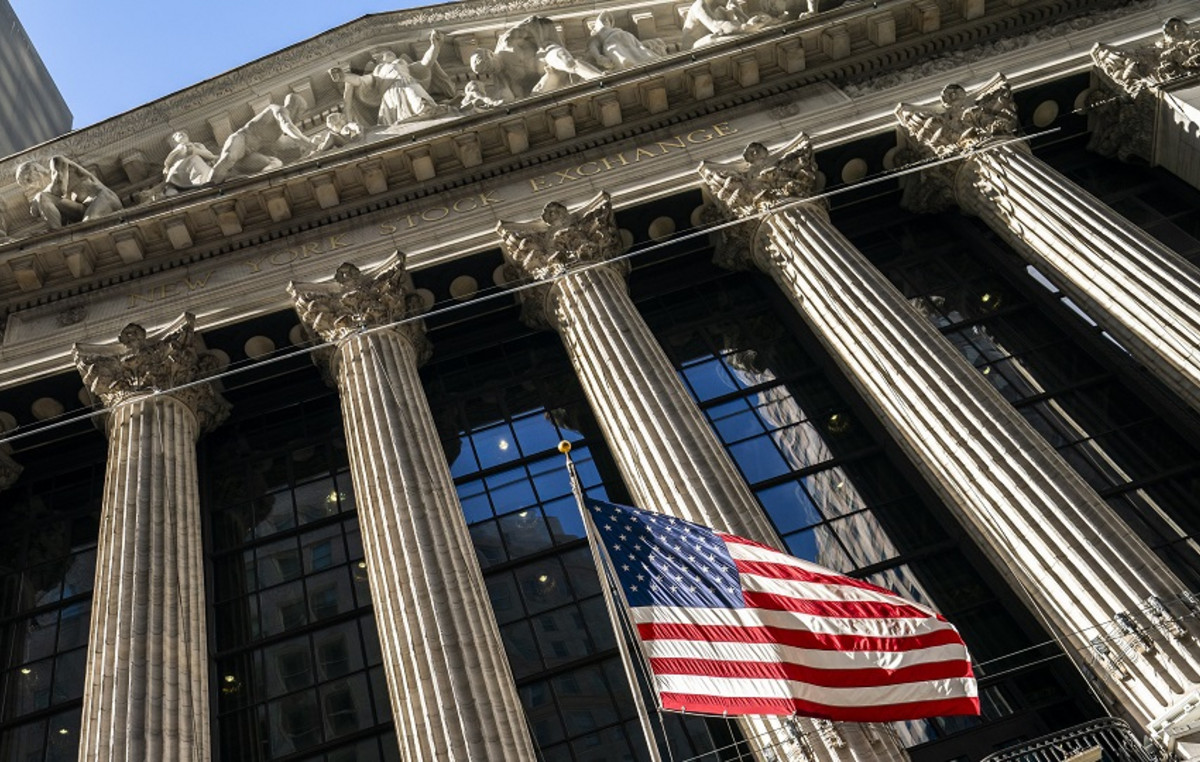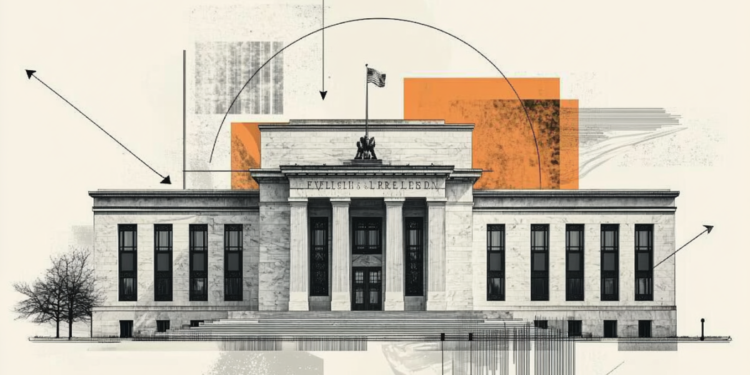- Indian rupee wins for the second day, supported by lower crude oil prices and a weaker US dollar.
- US President Donald Trump announces a “complete and total” ceasefire “between Iran and Israel, calming global energy markets.
- S&P Global Ratings raises the growth forecast of India for fiscal year 2025 to 6.5% and foresees moderate inflation in the future.
The USD/INR pair falls on Tuesday for the third consecutive day, since a decline in the global prices of crude oil and a weaker dollar improved the prospects for the commercial balance of India. The feeling improved after US President Donald Trump announced on the social networks that Iran and Israel had agreed to cease on fire, relieving the tensions that had maintained the energy markets in suspense in recent days.
At the time of writing, the USD/INR is lower than 86.00 during the European session, with a fall of around 0.50% in the day while the rupe extends its modest winning streak.
Meanwhile, the American dollar index (DXY) is still under pressure, sliding down 97.95 – close to its lowest level in almost three years – since the decrease in geopolitical tensions limits the demand of the dollar.
The global markets welcomed the news of the cessation to the fire, relieving some pressure on safe refuge assets and energy prices. The US president Donald Trump described him as a “complete and total” firefire through Truth Social, stating that they would stop the hostilities first, with Israel joining 12 hours later – a frame that he said was mediated through Qatar with the participation of high US officials, including vice president Vance and Secretary Rubio.
Israeli Prime Minister Netanyahu supported the plan, stating that his government had “achieved military objectives” and honor the US mediated pause.
Iran’s Foreign Minister Abbas Araghchi, at first he rejected to talk about a formal agreement, but then hinted at a decalidation, praising Iran’s armed forces for “fighting until the last minute” and the state media informing that the truce had begun.
Although Israel reaffirmed their commitment to the truce, some officials quickly accused Iran of violating the terms – accusations that Tehran has firmly denied. While this unfortunate has moderated geopolitical risk premiums, markets remain attentive to any revival that could quickly revive volatility in oil and currency markets.
Market movements: The rupee recovers as the actions are strengthened
- The Indian rupee, which had been under pressure since the Iran-Israel conflict broke out-falling to a minimum of three months-is now showing a solid recovery. Several global and domestic factors, including the decrease in geopolitical tensions, moderate oil prices and a weaker US dollar, have driven the strong rebound.
- Indian stock indices shot themselves as investors optimism increased, driven by the feeling of risk and lower oil prices. The BSE Sensex jumped almost 1% intradic, briefly adding more than 1,100 points before cutting profits to close approximately 158 points higher by 82,744. Similarly, NSE Nifty exceeded the 25,200 mark during the session and settled modestly above 25,000. The hopes of a durable ceasefire in the Middle East and a weaker dollar supported purchases in most sectors, although energy actions lagged due to the lowest prices of crude oil.
- After the strong mass sale on Monday, oil prices extended losses early on Tuesday, with the Brent briefly falling below the 70 $ brand for the first time in weeks, since optimism on a ceasefire Iran-Israel cut the geopolitical risk premium. However, prices then cut part of the intra -dialing – at the time of writing, the Brent is quoted by about $ 68,66 per barrel, while the WTI remains around $ 66.50. The softest energy market continues to relieve cost pressures for important oil countries such as India, offering support to rupee and the feeling of broader risk, although operators remain cautious about the fragile nature of the truce.
- S&P Global Ratings raised the projection of GDP growth of India for the current fiscal year to 6.5%, in the face of its previous estimate of 6.3%, Citing support factors such as the fall in crude oil prices, the perspective of a monetary relief and the expectations of a normal monzones season. The agency also pointed out that, although geopolitical tensions persist, they are unlikely that they believe “significant pressures” about rupee or fuel inflation risks, offering an encouraging background for currency and economy in general.
- The S&P economist, Vishrut Rana, told PTI that energy costs remain lower than last year – Brent oil averaged around $ 85 per barrel a year ago, compared to current levels. “This will help contain both current account flows and domestic energy price pressures – while energy prices can increase moderately, the path of food prices will have a greater impact on inflation. In general, we do not expect significant pressures on Indian rupee or inflation,” Rana added.
- The growth estimate for fiscal year 2026 of S&P for India is aligned with the projection of the Bank of the Reserve of India, setting the expansion of GDP by 6.5%. Together with a stronger growth, S&P forecasts that India inflation will moderate an average of 4% in 2025, decreasing from 4.6% in 2024.
- The US dollar index (DXY) is quoting on softer land as the markets prepare for new Federal Reserve policy (FED) clues. Recent comments from Fed officials, including vice president Michelle Bowman and governor Christopher Waller, have strengthened the expectations that feat cuts could arrive as soon as in July. All eyes are now in the testimony of the president of the Fed, Jerome Powell, before Congress later on Tuesday, that the operators hope that it provides a clearer guide on the path of the policy to follow.
Technical analysis: USD/INR is softened after the rupture of the triangle, Ema in focus

From a technical perspective, the USD/INR broke a triangle pattern of several months in early June, confirming a bullish bias.
The pair exceeded the resistance of the descending trend line, but about 86.80–87.00 was quickly found. This area has limited additional profits, resulting in a modest setback during the last three days.
The pair is now just above its 21 -day exponential (EMA) mobile average, which serves as immediate support around 85.90. Maintaining this level could help the bullies to regroup for another attempt at the recent maximum about 86.50, while a break below could expose the following support around 85.50 and the test of the higher tendency line of the triangle.
The impulse signals are showing early fatigue signs, indicating a possible volatile pricing action in the short term.
The relative force index (RSI), which recently reached a peak above 67, He has backed into the neutral zone of 50, suggesting that the bullish impulse is losing strength but has not yet been completely reversed.
If buyers defend the EMA support, the pair could maintain a slight bullish bias. However, a sustained fall below the area of 85.90–85.70 could encourage greater benefits, dragging the USD/INR back within the previous consolidation range.
Indian economy FAQS
The Indian economy has averaged a growth rate of 6.13% between 2006 and 2023, which makes it one of the fastest growing in the world. The high growth of India has attracted a lot of foreign investment. This includes foreign direct investment (FDI) in physical projects and indirect foreign investment (IIF) of foreign funds in Indian financial markets. The higher the investment level, the greater the demand for rupees (INR). Fluctuations in the demand for dollars by Indian importers also affect INR.
India has to import a lot of its oil and gasoline so that the price of oil can have a direct impact on the rupee. Petroleum is mainly marketed in US dollars (USD) in international markets, so if the price of oil increases, aggregate demand for US dollars increases and Indian importers have to sell more rupees to meet that demand, which depreciates the rupee.
Inflation has a complex effect on rupee. Ultimately, it indicates an increase in the money supply that reduces the general value of the rupee. However, if it exceeds the 4% objective of the Bank of the India Reserve (RBI), the RBI will increase interest rates to reduce it by reducing credit. The highest interest rates, especially real rates (the difference between interest rates and inflation) strengthen rupee. They make India a more profitable place for international investors to deposit their money. A fall in inflation can support rupee. At the same time, lower interest rates can have a depreciative effect on rupee.
India has had a commercial deficit during most of its recent history, indicating that its imports exceed its exports. Since most of the international trade is done in US dollars, there are moments (due to seasonal demand or excess orders) in which the high volume of imports generates a significant demand for US dollars. During these periods, rupee can weaken since a lot is sold to meet the demand for dollars. When markets experience greater volatility, the demand for US dollars can also be shot, with an equally negative effect on rupee.
Source: Fx Street
I am Joshua Winder, a senior-level journalist and editor at World Stock Market. I specialize in covering news related to the stock market and economic trends. With more than 8 years of experience in this field, I have become an expert in financial reporting.







